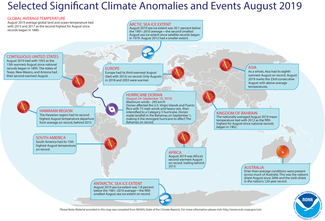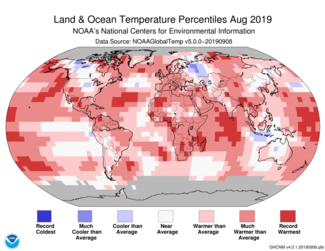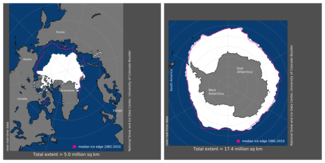Second warmest August and June–August for globe

The global land and ocean surface temperature departure from average for August 2019 tied as the second highest for the month of August in the 140-year NOAA global temperature dataset record, which dates back to 1880. The June–August 2019 temperature was also second highest and the January–August temperature was the third highest such period on record.
This monthly summary, developed by scientists at NOAA’s National Centers for Environmental Information, is part of the suite of climate services NOAA provides to government, business, academia and the public to support informed decision-making.
August 2019 Temperature
-
The August temperature across global land and ocean surfaces was 1.66°F above the 20th century average of 60.1°F and tied with 2015 and 2017 as the second highest for August in the 1880–2019 record. The five warmest Augusts have all occurred since 2014. August 2016 is the warmest August on record with a global land and ocean surface temperature departure from average of 1.76°F.
-
Record-warm August temperature departures from average prevailed across parts of the northern and western Pacific Ocean, the Bering Sea, northern and southern parts of North America, the Atlantic Ocean, Indian Ocean as well as parts of Africa and central Asia. No land or ocean areas had record-cold August temperatures.
-
The most notable warm surface temperature departures from average during August 2019 were present across parts of the North Pacific Ocean, the Bering Sea, northern Canada, the south-central contiguous U.S., the Baffin Bay, central Europe, north-central Russia, as well as parts of southern Africa and eastern Antarctica, where temperatures were at least 2.7°F above average or higher. The most notable cool temperature departures from average occurred across parts of northwestern Canada and western Russia. Temperature departures for these locations were at least 2.7°F below average or cooler.
-
-
The August globally averaged land surface temperature was 2.05°F above the 20th century average of 56.9°F. This value was the fourth highest August land temperature in the 140-year record.
-
Regionally, Europe, Africa and the Hawaiian region had an August temperature that ranked among their three highest August temperatures on record.
-
-
The August globally averaged sea surface temperature was 1.51°F above the 20th century monthly average of 61.4°F, the highest global ocean temperature for August on record. This value surpassed the previous record set in 2016 by 0.04°F.
August 2019 Sea Ice
-
The August average Arctic sea ice extent was the second smallest in the 41-year record at 838,000 square miles (30.1 percent) below the 1981–2010 average, according to an analysis by the National Snow and Ice Data Center using data from NOAA and NASA. The record smallest August Arctic sea ice extent was set in 2012 at 34.4% below average.
-
Antarctic sea ice extent during August was 120,000 square miles (1.8 percent) below the 1981–2010 average. This was the fifth smallest August extent on record.
Seasonal (June–August 2019)
-
The June–August 2019 average temperature across global land and ocean surfaces was 1.67°F above the 20th century average of 60.1°F and the second highest for June–August in the 1880–2019 record. June–August 2016 was the warmest such period on record at 1.71°F above average. The five warmest June–August periods have occurred in the last five years. The global land and ocean surface temperature for the three-month season has increased at an average rate of 0.13°F per decade since 1880; however, the average rate of increase is more than twice as great (0.32°F per decade) since 1981.
-
The Northern Hemisphere June–August 2019 land and ocean surface temperature tied with 2016 as the warmest such period in the 140-year record at 2.03°F above average.
-
The Southern Hemisphere June–August 2019 land and ocean surface temperature was 1.33°F above average and tied with 2015 as the second highest June–August temperature since global records began in 1880, trailing behind 2016 (1.37 above average).
-
Record-warm temperatures during the three-month period were present across parts of the western coast of Alaska, the Bering Sea, western Pacific Ocean, Mexico, the Atlantic Ocean, western and southern Africa, northern Indian Ocean, South America, Europe and Asia. No land or ocean areas had a record-cold June–August 2019 temperature.
-
The most notable warm surface temperature departures from average during June–August 2019 were present across much of the high latitudes in the Northern Hemisphere, specifically across the North Pacific Ocean, the Bering Sea, western Alaska, northern Canada, central Europe and north-central Russia. The temperature departures from average in these locations were at least +2.7°F or higher. The most notable cooler-than-average conditions were limited to western Canada, western Russia and parts of Indonesia and surrounding ocean, where temperatures were at least 1.8°F below average or cooler.
-
-
The globally averaged land surface temperature for June–August was the third highest on record at 2.20°F above the 20th century average of 56.9°F. Only 2016 and 2017 were warmer.
-
Regionally, South America, Europe, Africa, the Gulf of Mexico and the Hawaiian region had a June–August temperature departure from average that ranked among the three warmest such periods on record. Of note, Africa had its warmest June–August on record.
-
-
The June–August globally averaged sea surface temperature tied with 2016 as the highest for June–August on record at 1.48°F above the 20th century average of 61.5°F. The five warmest global sea surface temperature for June–August have occurred since 2014.
Year-to-date (January–August 2019)
-
The year-to-date temperature across global land and ocean surfaces was 1.69°F above the 20th century average of 57.3°F — the third highest for January–August in the 140-year record, trailing behind 2016 (+1.94°F) and 2017 (+1.71°F).
-
The year-to-date period was characterized by warmer-than-average conditions across much of the globe’s land and ocean surface. Notable warm temperatures were present across much of Alaska, northwestern Canada and central Russia, where temperatures were at least 4.5°F above average. The most notable cooler-than-average temperatures were present across much of the contiguous United States and the southern half of Canada, with temperatures at least 1.8°F below average or cooler.
-
Record-warm temperatures during the year-to-date period were present across parts of the southern half of Africa, Australia, Alaska, Mexico and Asia, as well as across New Zealand and its surrounding ocean, western Indian Ocean and North Pacific Ocean. No land or ocean areas had record-cold temperatures during January–August 2019.
-
-
The year-to-date globally averaged land surface temperature was 2.56°F above the 20th century average of 48.1°F. This value was also the third highest for January–August on record — only 2016 and 2017 were warmer.
-
Regionally, South America, Europe, Africa, Asia, Oceania and the Hawaiian region had a January–August 2019 temperature departure from average that ranked among the five highest such period on record.
-
-
The year-to-date globally averaged sea surface temperature was 1.37°F above the 20th century average of 61.1°F. This was the second highest for January–August in the 1880–2019 record, trailing behind 2016 by 0.13°F.
For a more complete summary of climate conditions and events, see our August 2019 Global Climate Report.








